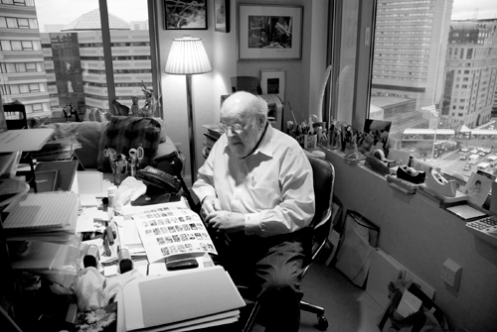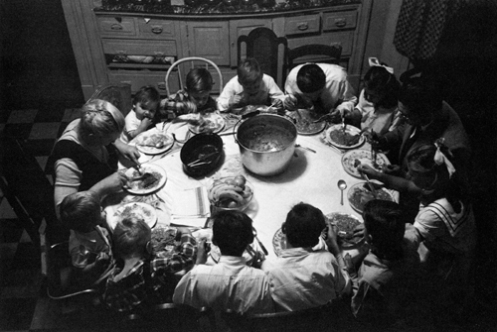An Interview with Béla Kalman
 By Jim Fitts
By Jim Fitts
Executive Director
The Photographic Resource Center at Boston University
Béla Kalman enjoys a unique perspective on Boston. His fourteenth floor condominium overlooks both Copley Square and the Back Bay. But the most unique perspective Béla enjoys comes from his career as a photographer in both Europe and America, including owning a very successful photography studio in Boston on Newbury Street for twenty-two years.
Cate Brennan, Jason Landry, and I spent an afternoon last fall with Béla discussing his career and asking him questions about a few of his more intriguing photographs.
Béla started off by telling us that being “87 years old isn’t easy.” Béla’s enthusiasm and energy makes you wonder if that is true.
He has published ten books. His eleventh book on Matisse, he says will be his last.
Throughout his long career, Béla has had the opportunity to meet and work with many of the photographic heroes of the 20th century “I photographed Karsh in 1957 in the style of the portraits he made,” Béla says. “I met his wife a few years back and told her about it. She asked me for a copy of the photograph. I made her a 16×20. She thought it was nice because she didn’t know him in 1957 when the image was made.”
I was aware that Béla had worked for Life Magazine and I wanted him to expand on that experience.
“I was working at this commercial studio in Chicago schlepping around as an assistant. After a year I wrote a letter to Henry Luce, the head of Time Life, telling him that I am here in America and I’m ready to work for your magazine… please give me a chance to show you what I can do. My aunt and uncle who came years earlier said, ‘You are a fool, this isn’t how America works. Low and behold, two weeks later I got a registered letter to report to get an assignment at the Time Life bureau.’” “You can work for us if you have a story,” they told Béla. “I sat in their library and I came up with sixteen story ideas.”
“It was the first anniversary of the 1956 Hungarian Revolution and Life Magazine wanted to have a spread of Hungarians who settled in America and how they were doing after one year. I had a journalist with me, my English wasn’t that good at the time. Their research department came up with thirty six families for me to contact. One of them was a doctor’s family with eleven children and his wife was pregnant with their twelfth child.”
“We went to sixteen places. We shot all day, from 8am until 8pm, shoot, shoot, shoot, shoot. I had thee cameras with a wide angle, normal and a telephoto hanging on my neck. I was dead tired by 8pm. We’d have dinner, go to the airport and then we’d be off to the next destination.”
“I have all the Life Magazine negatives. I handed them over to them and they handed them back a few years later. Sixteen interviews and sixteen pictures were going to be published. Five minutes before press they stopped the press. The 1917 Russian Revolution’s 50th anniversary coincided with this Hungarian article. They cut the article out and put in sixteen pages of the Russian revolution. I was a Life Magazine photographer, but my pictures never appeared in the magazine.”

The image above is from that never-printed article. Béla told me that the image was lit from one light bulb that hung from the ceiling.
I asked Béla about his photograph of Japanese master artist, Shiko Munakata. “In 1959, I did this portrait for New York Times Magazine. Mr. Munakata allowed me to let me take some pictures. He made these life-size pictures, and this man was about five feet. Each time he had his brush he made this grunt…Buh, Buh.”

Shortly afterward, Béla moved to Boston. “In 1960, I came to Boston because I was bored with my job in New York City and I read an advertisement in the New York Times help wanted section. A creative advertisement photographer is wanted in Boston for one of the leading advertising studios. I had an interview and the interviewer said there is a Prudential Center being built with sixteen floors of advertising agencies.”
For twenty-two years Béla worked for every major advertising agency in Boston.
Béla’s published work covers a wide variety of topics including travel photographs as well as his photographs of flowers.
“In Hungary I had a portrait studio. One day another photographer called me and said there was a flower show. Would you mind coming with me to photograph the various booths. On Saturday afternoon I went to the flower show, the first photograph I made was of Gerbera Daisies, which even today is his signature image.”
“There is an orchid grower and gardener in Hyannis, Massachusetts and when the idea came that there were enough varieties of orchids to photograph, I made a book. I sent the idea to Bulfinch and a sampling of images and low and behold, they called me at 7pm one evening and told me that they wanted to publish my book. I fell off whatever I was sitting on. This was the easiest book to publish.” Béla then added, “Books are not good business; you get a very small percentage of return.”
When asked about his book of photographs of Tuscany, Béla stated, “I went to Tuscany five times. My favorite image from that book is the lone tree on the top of the hill. To spot this is the trick. To travel on the road and stop the car and see something as you are driving. In this case, my wife was driving.”
At the end of our interview I asked Béla if there was any advice he might have for young photographers. He replied, “I think that the less you shoot, the more sophisticated you are with your subject. That is what artistic photography is all about. Today taking a photograph is entirely different, because the moment after you shoot it you can see it.”
Image: Jim Fitts, Béla Kalman working on his latest book, 2008.
Image: Béla Kalman, Family Dinner, Chicago, 1957 from the book,The Third Eye.
Image: Béla Kalman, Munakata at Work, New York City, 1959 from the book, The Third Eye.
